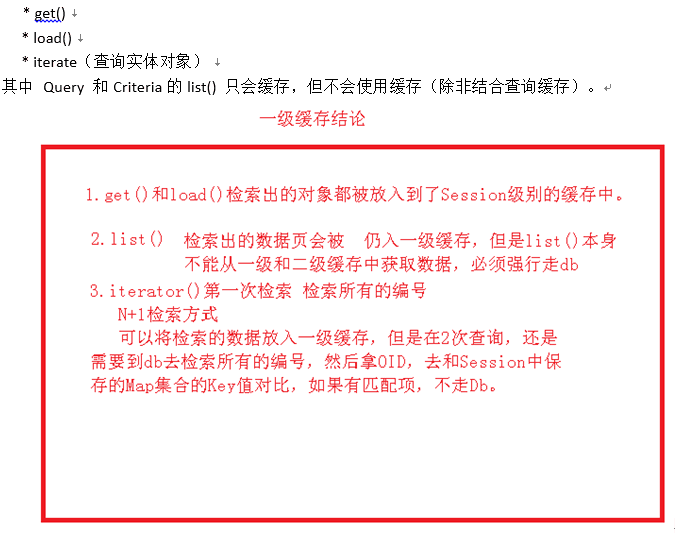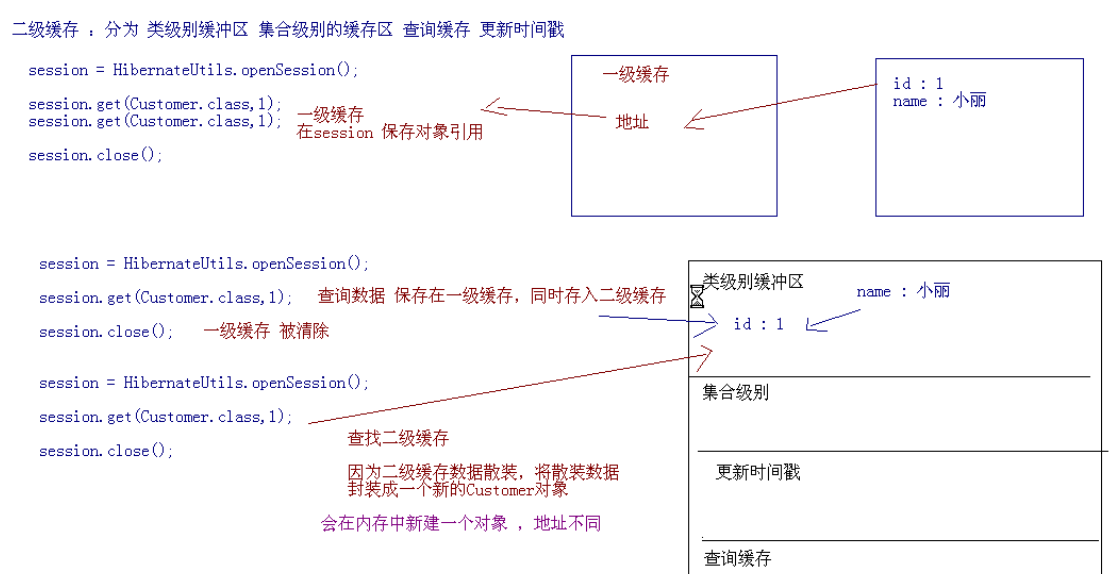初识Hibernate 缓存
生活就像一杯咖啡,让你我慢慢的品尝,品尝它的苦涩和甘甜......
一、什么是Hibernate缓存。
解析:白话来说就是缓存数据的容器
官方标准点缓存:是计算机领域的概念,它介于应用程序和永久性数据存储源之间。
作用:降低应用程序直接读写数据库的频率,从而提高程序的运行性能。缓存中的数据是数据存储源中数据的拷贝。缓存的物理介质通常是内存。
二、缓存一般分为三个类
一级缓存
二级缓存
查看缓存
三、一级缓存
场景一:使用同一个session连续查询两次同一个对象
/查询学生信息
public static void select(){ //由班级查询该班级学生信息
Session session=HibernateUtil.currentSession();
Grade grade=(Grade) session.get(Grade.class, );
//输出班级信息
System.out.println(grade.getGname());
Grade grade2=(Grade) session.get(Grade.class, );
//输出班级信息
System.out.println(grade2.getGname());
}
执行结果:

场景一:在第一次查询完毕后,关闭session对象,重新开启一个session然后继续查询同一个对象
//查询学生信息
public static void select(){ //由班级查询该班级学生信息
Session session=HibernateUtil.currentSession();
Grade grade=(Grade) session.get(Grade.class, );
//输出班级信息
System.out.println(grade.getGname());
//关闭session
HibernateUtil.closeSession();
//重新获取session
session=HibernateUtil.currentSession();
Grade grade2=(Grade) session.get(Grade.class, );
//输出班级信息
System.out.println(grade2.getGname());
}
执行结果:

解析:
1:当我没有关闭session时用的同一个session两次访问同一个对象时,只会向DB端发送一条sql语句
* 原因:因为我第一次访问数据库的时候Hibernate会自动的将我查询出来的结果保留一份查询出来的对象到一级缓存
并且这个额对象是根据OID唯一标识的,也可以理解为数据库中的主键值,然后当我再一次访问一个对象时,Hibernate
机制会自动的先去一级缓存中查找看有没有OID与我要查询的OID相同的对象,如果有的话,则直接从一级缓存中 拿数据
如果没有相同的OID则说明缓存中没有我要的记录,那么就会直接去访问DB端了,这样的话,又会重新发送一条sql
2:当我第一次查询完数据后立即关闭session,这时重新开启一个session来访问同一个对象,这时我们会发现它居然向数据库发送了两条Sql语句。这是为什么呢?
* 原因:其实原因很简单,因为我们虽然说是访问的同一个对象,但是我们随即就关闭了这个session而重新开启了一个session,
此时我们访问时的session是不一致的也就是说是两个不同的session发出的请求,这样理解的话,我们就不难理解了。
所以总结出,一级缓存是一个会话级别的缓存,当一次回话结束后该会话里的缓存则会全部的销毁,所有我们自然就只能重新发送一条sql啦。
3补充以下方法支持一级缓存

四、二级缓存
(一)配置二级缓存
1.引入如下jar包。
ehcache-1.2.3.jar 核心库
backport-util-concurrent.jar
commons-logging.jar
2.配置Hibernate.cfg.xml开启二级缓存
<property name="hibernate.cache.use_second_level_cache">true</property>
3.配置二级缓存的供应商
<property name="hibernate.cache.provider_class">org.hibernate.cache.EhCacheProvider</property>
4.指定使用二级缓存的类
方案一:在*.hbm.xml中配置
在<class元素的子元素下添加chche子节点,但该配置仅会缓存对象的简单属性,若希望缓存集合属性中的元素,必须在set元素中添加<cache>子元素
<class name="Student" table="STUDENT">
<cache usage="read-write"/>
方案二:在大配置文件(hibernate.cfg.xml)中配置
<class-cache usage="read-write" class="cn.happy.entity.Student"/>
<collection-cache usage="read-write" collection=""/>--可注释如果配置不成功
注意大配置的书写位置
Multiple annotations found at this line:
- The content of element type "session-factory" must match "(property*,mapping*,(class-cache|collection-
cache)*,event*,listener*)".
- Start tag of element <session-factory>
*5.在src下添加ehcache.xml文件,从etc获取文件即可。
<ehcache>
<!-- Sets the path to the directory where cache .data files are created.
If the path is a Java System Property it is replaced by
its value in the running VM.
The following properties are translated:
user.home - User's home directory
user.dir - User's current working directory
java.io.tmpdir - Default temp file path -->
<diskStore path="d:/tmp"/>
<!--Default Cache configuration. These will applied to caches programmatically created through
the CacheManager.
The following attributes are required for defaultCache:
maxInMemory - Sets the maximum number of objects that will be created in memory
eternal - Sets whether elements are eternal. If eternal, timeouts are ignored and the element
is never expired.
timeToIdleSeconds - Sets the time to idle for an element before it expires. Is only used
if the element is not eternal. Idle time is now - last accessed time
timeToLiveSeconds - Sets the time to live for an element before it expires. Is only used
if the element is not eternal. TTL is now - creation time
overflowToDisk - Sets whether elements can overflow to disk when the in-memory cache
has reached the maxInMemory limit.
-->
<defaultCache
maxElementsInMemory=""
eternal="false"
timeToIdleSeconds=""
timeToLiveSeconds=""
overflowToDisk="true"
/>
<!--Predefined caches. Add your cache configuration settings here.
If you do not have a configuration for your cache a WARNING will be issued when the
CacheManager starts
The following attributes are required for defaultCache:
name - Sets the name of the cache. This is used to identify the cache. It must be unique.
maxInMemory - Sets the maximum number of objects that will be created in memory
eternal - Sets whether elements are eternal. If eternal, timeouts are ignored and the element
is never expired.
timeToIdleSeconds - Sets the time to idle for an element before it expires. Is only used
if the element is not eternal. Idle time is now - last accessed time
timeToLiveSeconds - Sets the time to live for an element before it expires. Is only used
if the element is not eternal. TTL is now - creation time
overflowToDisk - Sets whether elements can overflow to disk when the in-memory cache
has reached the maxInMemory limit.
-->
<!-- Sample cache named sampleCache1
This cache contains a maximum in memory of elements, and will expire
an element if it is idle for more than minutes and lives for more than
minutes.
If there are more than elements it will overflow to the
disk cache, which in this configuration will go to wherever java.io.tmp is
defined on your system. On a standard Linux system this will be /tmp"
-->
<cache name="sampleCache1"
maxElementsInMemory=""
eternal="false"
timeToIdleSeconds=""
timeToLiveSeconds=""
overflowToDisk="true"
/>
<!-- Sample cache named sampleCache2
This cache contains elements. Elements will always be held in memory.
They are not expired. -->
<cache name="sampleCache2"
maxElementsInMemory=""
eternal="true"
timeToIdleSeconds=""
timeToLiveSeconds=""
overflowToDisk="false"
/> -->
<!-- Place configuration for your caches following -->
</ehcache>
(二)二级缓存散装数据原理图
解析:每次从二级缓存中取出的对象,都是一个新的对象。

(三)什么样的数据适合放入二级缓存中?
1很少被修改的数据
2不是很重要的数据,允许出现偶尔并发的数据
3不会被并发访问的数据
4参考数据,指的是供应用参考的常量数据,它的实列数目有限,它的实列被许多其他类的实列引用,实列极少或者从来不会被修改。
讲述几乎结束了!!!
初识Hibernate 缓存的更多相关文章
- Hibernate 缓存机制浅析
1. 为什么要用 Hibernate 缓存? Hibernate是一个持久层框架,经常访问物理数据库. 为了降低应用程序对物理数据源访问的频次,从而提高应用程序的运行性能. 缓存内的数据是对物理数据源 ...
- hibernate缓存机制(转)
原文出处:http://www.cnblogs.com/wean/archive/2012/05/16/2502724.html 一.why(为什么要用Hibernate缓存?) Hibernate是 ...
- 【转】hibernate缓存:一级缓存和二级缓存
什么是缓存? 缓存是介于物理数据源与应用程序之间,是对数据库中的数据复制一份临时放在内存中的容器,其作用是为了减少应用程序对物理数据源访问的次数,从而提高了应用程序的运行性能.Hibernate在进行 ...
- Hibernate缓存(转)
来自:http://www.cnblogs.com/wean/archive/2012/05/16/2502724.html 一.why(为什么要用Hibernate缓存?) Hibernate是一个 ...
- Hibernate缓存原理与策略
Hibernate缓存原理: 对于Hibernate这类ORM而言,缓存显的尤为重要,它是持久层性能提升的关键.简单来讲Hibernate就是对JDBC进行封装,以实现内部状态的管理,OR关系的映射等 ...
- [原创]java WEB学习笔记93:Hibernate学习之路---Hibernate 缓存介绍,缓存级别,使用二级缓存的情况,二级缓存的架构集合缓存,二级缓存的并发策略,实现步骤,集合缓存,查询缓存,时间戳缓存
本博客的目的:①总结自己的学习过程,相当于学习笔记 ②将自己的经验分享给大家,相互学习,互相交流,不可商用 内容难免出现问题,欢迎指正,交流,探讨,可以留言,也可以通过以下方式联系. 本人互联网技术爱 ...
- Hibernate缓存原理与策略 Hibernate缓存原理:
Hibernate缓存原理: 对于Hibernate这类ORM而言,缓存显的尤为重要,它是持久层性能提升的关键.简单来讲Hibernate就是对JDBC进行封装,以实现内部状态的管理,OR关系的映射等 ...
- Hibernate 缓存机制
一.why(为什么要用Hibernate缓存?) Hibernate是一个持久层框架,经常访问物理数据库. 为了降低应用程序对物理数据源访问的频次,从而提高应用程序的运行性能. 缓存内的数据是对物理数 ...
- hibernate缓存说明
hibernate缓存说明: 1.一级缓存(session级别缓存) 一级缓存,不是用来提升性能,是用来处理事务的 2.二级缓存(sessionFactory级别缓存): 二级缓存,对 ...
随机推荐
- 简述移动端IM开发的那些坑:架构设计、通信协议和客户端
1.前言 有过移动端开发经历的开发者都深有体会:移动端IM的开发,与传统PC端IM有很大的不同,尤其无线网络的不可靠性.移动端硬件设备资源的有限性等问题,导致一个完整的移动端IM架构设计和实现都充满着 ...
- 【转】Spring MVC中Session的正确用法之我见
Spring MVC是个非常优秀的框架,其优秀之处继承自Spring本身依赖注入(Dependency Injection)的强大的模块化和可配置性,其设计处处透露着易用性.可复用性与易集成性.优良的 ...
- Ucos系统常用的数据结构有哪些?
1)表 链表 表中主要了解链表,尤其是单向链表. 2)数组 一维数组 二维数组 使用数组有什么好处,在c语言中,数组是一组连续数字的集合它们数组的下标,代表了数组的相对位置,所以说,在一些高效的查表过 ...
- 依赖注入(DI)与服务容器(IoC)
参考文章:http://www.yuansir-web.com/2014/03/20/%E7%90%86%E8%A7%A3php-%E4%BE%9D%E8%B5%96%E6%B3%A8%E5%85%A ...
- 【.Net底层剖析】3.用IL来理解属性
.Net底层剖析目录章节 1.[深入浅出.Net IL]1.一个For循环引发的IL 2.[.Net底层剖析]2.stfld指令-给对象的字段赋值 3.[.Net底层剖析]3.用IL来理解属性 未完待 ...
- HTML5标签嵌套规则
× 目录 [1]分类 [2]子元素 [3]总结 前面的话 在html5中,<a>元素的子元素可以是块级元素,这在以前是被认为不符合规则的.本文将详细介绍html5的标签嵌套规则 分类 ht ...
- Cocos2d-x 3.2 学习笔记(十四)保卫萝卜之界面UI
保卫萝卜~上一篇说了使用CocoStudio制作主界面,这里来完善主界面动画及后续界面(主题界面ThemeUI.场景选择界面SelectMapUI),主要涉及的控件PageView. 学习要 ...
- Android基于mAppWidget实现手绘地图(十二)–显示当前用户位置
若显示当前用户位置,你需要执行以下步骤: 1.添加ACCESS_COARSE_LOCATION 和ACCESS_FINE_LOCATION权限在AndroidManifest.xml中 2.用mapW ...
- PHP面向对象中的重要知识点(二)
1. __toString: 当对象被打印时,如果该类定义了该方法,则打印该方法的返回值,否则将按照PHP的缺省行为输出打印结果.该方法类似于Java中的toString(). <?php cl ...
- 分享一个Jquery 分页插件 Jquery Pagination
分页插件来说,我觉得适用就行,尽量简单然后能够根据不同的应用场景能够换肤.展现形式等. 对于初学者想写分页插件的同学,也可以看下源码,代码也挺简单明了的,也助于自己写个小插件. 不过我比较懒,一般直接 ...
